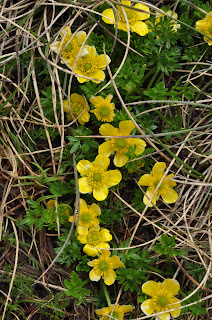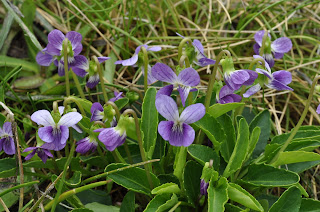Kosciuszko
Alpine plants.
It is 10 years since the four of us were at Mt Kosciuszko, 100 square kilometres of truly alpine area and Australia's highest mountain 2228 meters, of course the The Snowy Mountain alpine area is much larger 250 square kilometres. We were only going to Kosciuszko so we had to choose our day to go to the top as there were snow flurries and minus temperatures and we would not be staying on the track so visibility was very important to us, so we ventured on the chair lift to the top on our third and fourth days, third day was cloudy and cold but fourth day was sunny and a glorious day. On our first day we were intending to go on Charlottes Pass Track to the Feldmark area to see Ranunculus acropolis and Ranunculus muelleri the two most glorious Ranunculus you will ever see, bright yellow buttercup flowers with leaves covered in dense brown hair. This was not to be the case as the creek we usually cross over was waist high in rushing water and Ray was the only one prepared to wade through the water. So we pottered around down near the creek and then attempted to walk back up to the top.
We did see all the plants that we wanted to find over the four days that we had, except the two Ranunculus acropolis and R muelleri and the Caltha introloba was not in flower. Ray found two plants that we had never photographed before Drosera aecturi flowering in a very wet seep area and Euphrasia collina subsp lapidosa in a Feldmark area, two exciting new finds for us.
(please click on photos to see full size and more detail)
Aciphylla glacialis (Mountain celery) named because it smells and looks like celery stalks. There are male and female plants. (above and below)
Blechnum penna-marina subsp. alpina (Alpine water fern) growing in the crevices of rocks.
Brachyscome spathulata subsp. spathulata (Spoon daisy) mauve to lilac flowers, quite large flower heads for its size 4cm across. Height approx 15cm
Celmisia costiniana (Herbfield Celmisia) large drifts in the herbfields as its common name suggests.
Celmisia pugioniformis (Dagger-leaf Celmisia) it can be tufted or form large mats in tall alpine herbfield.
Celmisia tomentella (Bog Clemisia) more commonly found in the wetter parts of Kosciuszko in the sub alpine areas than the alpine tract. Photo taken Charlottes Pass which is a more moisture laden soil.
Craspedia costiniana? an endemic to Kosciuszko (I'm not sure about this plant it did not match any reference I had.)
Craspedia maxgrayi (Wooly Billy-button) robust species widely spread in the herbfields
Height 30-60cm.
Dichosciadium ranunculaceum var. ranunculaceum (Wreath Pennywort) an endemic of Kosciuszko is a rosette plant with a thick taproot forming large patches, large lobed hairy leaves. Height 10cm gets taller as it ages.
Drosera arcturi (Alpine sundew) solitary white flowers and strapped shaped leaves with sticky glandular hairs that traps insects. It is the only insectivorous species above the tree line.
A treasured find Euchiton nitidulus with the cushion forming Colobanthus nivicola in flower.
Euphrasia collina subsp. diversicolor (Variable Eyebright) is the largest and most wide spread of all the Euphrasia's and is all shades of mauve to pink and found growing in most positions. Height 30cm.
Euphrasia collina subsp lapidosa (Feldmark Eyebright) Low-growing endemic feldmark subspecies, with the leaves crowded together on the stems. One of our new finds this year.
Ewartia nubigena (Silver Ewartia) forming large mats and in full flower. Height 5cm.
"The massed flowering which now occurs in summer is surpassed in few other parts of the world"
Alec Costin. When you read about the burning of the Alpine herb fields by NSW Department of Lands, sheep and cattlemen for grazing, its a wonder any natural vegetation is still there. In 1958 all areas in the Park above 1,370m had been withdrawn from grazing. It is still a very fragile area.
Leucochrysum albicans subsp alpinum (Alpine Sunray) a spectacular everlasting of exposed herbfields and feldmark areas, has large white papery flower heads and silvery woolly leaves. Always brings a flutter of excitement finding the first plant.
Microseris lanceolata (Native dandelion) large yellow flower heads on long stalks.
A mixture of foliage, with the grey leaves of Craspedia maxgrayi (Wooly Billy-button).
Pentachondra pumila (Carpet Heath) Large mat forming subshrub that we had not seen in flower and berry as much as this year. Mostly always in berry with scattered flowers but not smothered in fruit and flower as this year. Some of the old flowers are held on the end of the fruits. Height 15cm.
Pimelea alpina (Alpine Rice Flower) not a good common name at all, it resembles Daphne flowers that we saw growing in the mountains of Spain with its beautiful perfume. Flowers vary in colour from white to deep pink. Height 30cm and can be prostrate growing too.
Prasophyllum alpestre (Highland Leek-orchid) was growing everywhere, with large white and mauve tinged flowers with a dark centre. Height 30-60cm.
Prostanthera cuneata (Alpine mint Bush) with its beautifully marked flowers and perfumed minty leaves small shrub. Height is 0.5-1.5m
Ranunculus anemoneus (Anemone Buttercup) endemic to Kosciuszko named by Ferdinand Mueller (later Baron von Mueller) wrote "One of the most remarkable plants is assuredly a large flowering Ranunculus with generally numerous and always white petals having much the habit of an Anemone. It grows seldom below 6000ft and chiefly on springs and on the margins of melting snow" which is where Ray found it. I was going to crop the photo but thought you need to see full size as it gets tatty at the end of its days. A newly opening bud below has a pink-blush to outside petals, so special. Ferdinand Mueller is a story in itself. Height 30-35cm. flowers are 6-7cm across.
Ranunculus graniticola (Granite Buttercup) broadly dissected leaves, yellow flowers can either have a green centre or a dark centre as shown above. Height 15cm.
Richea continentis (Candle Heath) creamy flowers borne on reddish stems, forms large drifts and gets to a height of 1meter.
Scleranthus biflorus (Twin-flower Knawel) forms compact green cushions.
Senecio pinnatifolius var. pleiocephalus (Highland groundsel) is supposed to be common but we only found one plant in flower. Height 15 - 30cm.
Large spider hole built up around the edges so it does not flood, 6cm across by 5cm in depth. Glad we did not see him or her.
Stackhousia pulvinaris (Alpine Stackhousia) forms compact mats with sweetly perfumed creamy-yellow star shaped flowers. Plant is 5cm in height approximately.
Stylidium sp. (aff. graminifolium) (Trigger-plant) 20-30cm high. When the base of the irritable column or 'trigger' is touched by an insect in search of nectar it springs downwards and dusts the insect's back with pollen before it goes to the next flower, thus the next flower is pollenated.
Viola betonicifolia subsp. betonicifolia (Showy violet) comes in several different colours from almost white to dark violet flowers, with a very strong fragrance that you can smell all around you.
Height 10cm (above and below)
.
Wahlenbergia ceracea & Craspedia aurantia.
From left Viv, Ray, George and Joy.
Apologies for mis identified plants but one does ones best, would love to know if you think I have a plant wrongly named.








































No comments:
Post a Comment